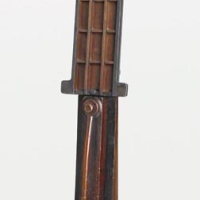50. ROBERT KLIPPEL

Experts agree that Robert Klippel was Australias greatest Modern sculptor. The present bronze Opus 807 of 1986, created when the artist was sixty-six years of age, is a significant hallmark example of his stately sculptures based upon the relatively rare Sentinel theme developed during the early to late Eighties.
The Eighties saw Klippel produce a number of significant individual cast bronze sculptures that depend upon a range of similar vertical sentinel formats with cascades of interrelated semi-mechanical parts all of them part of a stream of themes that he sporadically dipped into until 1987 the year after the date of the present work.
These sculptures all reflect the visual impact that Klippel saw in the vertical columnar formats seen in some Japanese Tomb Figures; Aboriginal Grave Posts; steel girders and mechanical presses. All this may be discerned in the following: Opus 390 (1981), Opus 412 (1981), Opus 415 (1981), Opus 422 (cast silver, 1982) and Opus 467 (1982) all in the Andrew Klippel Collection in Sydney; Opus 414 (1981) in the Tasmanian Museum and Art Gallery Collection in Hobart; Opus 522 (1983) in the Rosemary Madigan Collection in Yass; Opus 661 Sentinel (1987) in the La Trobe University Collection in Melbourne; Opus 657 (1987) in the Tom Lowenstein Collection in Melbourne and, of course, in the present work Opus 807 of 1986.
Considered in this stylistically linear way, Klippels Opus 807 not only sits in distinguished company but also shows distinct thematic and formal links back to his first major bronze commission: that of the so-called Group of Eight sculptures (Opuses: 365, 366, 367, 368, 369, 370, 371 and 372) in the Sculpture Garden of the National Gallery of Australia.
Importantly, for Klippel, the initial idea for all sculptures always came from the various things of the observable world. He never created purely abstract works for him sculpture was the embodiment of a real thing rather than the embodiment of an abstract idea or of what he would have called a non-thing.
In other words, Klippel always wanted to create new things that added to the world of things. This urge was never a search for mere novelty or nonconformist difference; on the contrary, it was based upon a firmly held yet modestly expressed belief that the true Modern artist must avoid replicating the things that were already in it. That is, any Modern artist with any artistic integrity had to create the new rather than re-create the old.
It is a little-known fact that the great Robert Hughes camped outside Sydneys Clune Galleries so that he could get one of Klippels sculptures from his solo exhibition there in September 1963. Such was their quality. James Gleeson, the Sydney artist, certainly agreed with this assessment as did James Mollison, the founding Director of the National Gallery of Australia. In fact Australias art world agreed and in 2002 he was the subject of a very successful retrospective, entitled Robert Klippel: A Tribute Exhibition, at the Art Gallery of New South Wales.
Back in 1980, Mollison urged Klippel to apply for an Australia Council grant to investigate bronze casting techniques. The successful grant afforded him the opportunity to diverge from his usual processes of fabrication and to recontextualize his sculptural constructions. Klippels development from wood assemblage to bronze cast sculpture during the early to late Eighties extended the parameters of reuse and recycling to an artistic form of upcycling where found and pre-fabricated objects were technically remade and materially transmuted. In short, bronze casting allowed Klippel to push his sculptural assemblages toward a new architectonic unity.
The present bronze sculpture was cast from the original painted wood assemblage of the same title (in the famous Laverty Collection) in a very limited edition of six identical works. The casting was carried out by Peter Morley AO at the Meridian Gallery in the Melbourne suburb of Richmond in 1986.
Klippels large bronze Opus 807 of 1986 has an impressive stylistic lineage; it delivers a space filling artistic impact and exudes an almost majestic ambience; it is is a notable example of the artists interest in the spatiality and aesthetic qualities of vertical forms in the Eighties.
Menzies Art Brands Note:
Dr. Ken Wach wrote the catalogue for the exhibition Robert Klippel: The American and European Years at Galerie Gmurzynska in Zrich in June 2013 the first Klippel exhibition in Europe for sixty-three years. He was also invited to give an address at the exhibition opening at the Baur au Lac Hotel in Zrich. Robert Klippel is internationally represented by Galerie Gmurzynska in Zrich, Switzerland.
Literature
Edwards, D., Robert Klippel: Large Wood Sculptures and Collages, Art Gallery of NSW, Sydney, 1995.
Edwards, D., Robert Klippel, Art Gallery of New South Wales, Sydney, 2002.
Gleeson, J., Robert Klippel, Bay Books, Sydney, 1983.
Hughes, R., Art in Vogue. Robert Hughes Writes on Robert Klippel, Vogue Australia, Sydney, November-December 1963.
Hughes, R., Robert Klippel, Art and Australia, vol. 2, no.1, Sydney, May 1964.
Lynn, E., When Whimsy is Strangled by Scrap Metal Monumentality, The Bulletin, Sydney, 1 March 1969.
Scarlett, K., Australian Sculptors, Nelson, Melbourne, 1980.
Scarlett, K., Robert Klippel: Australias Greatest Sculptor, Sculpture, vol.23, no.3, April 2004.
Wach, K., Robert Klippel: The American and European Years, Galerie Gmurzynska, Zrich, 2013.
Wach, K., Robert Klippel: Opus 995 of 1998, Galerie Gmurzynska, Basel Art Fair Miami, Florida, 2013.
Associate Professor Ken Wach
Dip. Art; T.T.T.C.; Fellowship RMIT; MA; PhD,
Former Principal Research Fellow and Head of the School of Creative Arts,
The University of Melbourne